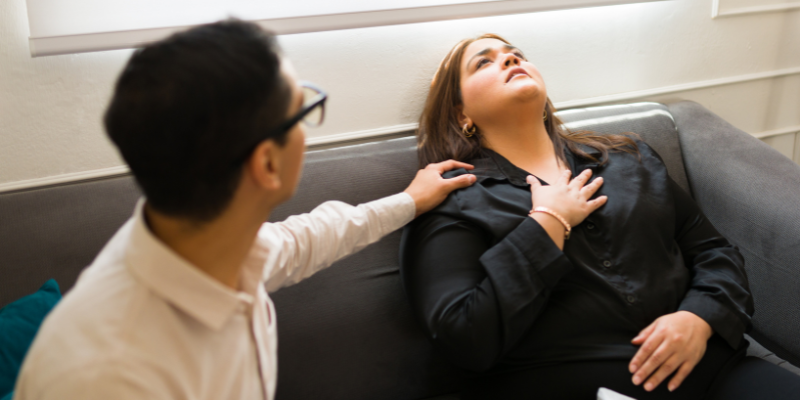A panic attack is a severe episode of fear or anxious feelings that often come without warning and leave the person powerless. These episodes have the potential to be very terrifying, with a rapid onset in which intense fear or discomfort lasts for only a few minutes. Knowing what a panic attack is for those experiencing it and friends and relatives who may want to offer comfort is essential.
A panic attack can best be said to be an abrupt onset of overwhelming fear or discomfort that comes with varied physical and emotional symptoms. Anyone experiencing an attack usually feels like they are losing control of the situation or, in the worst cases, actually believe they are having a heart attack. Such an elevated level of anxiety may provoke the feeling of estrangement from reality and, by the end of the episode, leave a person drained and exhausted.

Recognizing the Signs
You are likely to recognize symptoms before you help a person during a panic attack. Some of the symptoms include:
- A racing heart is one of the most often mentioned physical feelings that people note during an episode. It usually feels like the heart is pounding against the chest, invoking an immediate fear of a severe cardiac problem.
- Difficulty Breathing: People often experience trouble breathing or feel like they are choking or smothering. Those panic symptoms can sometimes create cycles of anxiety because they may fear that they're unable to get sufficient oxygen.
- Pain and Pressure in the Chest: The pressure or pain inside the chest can be scary, which sometimes mistakenly manifests as a heart attack. A person may clutch his chest, thinking that something is wrong.
- Dizziness or Feeling Dizzy: Dizziness or a spinning sensation may also make an individual fear that he may faint or become unconscious.
- Trembling or Shaking: Another very commonly occurring body symptom of anxiety is that the person's hands start to tremble or shake. This can be a frightening reaction and adds to the general panic attack.
- Sweating and Chills: Sweating and chills can occur when a person turns hot or sweaty and then suddenly cools down. This can give a general feeling of unease and apprehension.
- Nausea or Gastrointestinal Distress: Often, panic causes the body to experience a tremendous feeling of nausea, an upset stomach, and even diarrhea.
How to Assist Someone Who Is Having a Panic Attack
- Emotional Validation: You let them know you can understand what they are going through and that it's okay to feel this way, too.
- Invite Deep Breathing: Encourage the person to breathe slowly and slowly, and pause. Guide the patient through slow, deep breathing by counting:
- Inhaling deep for four counts
- Hold your breath for four counts
- Slow release for four counts.
- Create a Quiet Space: If possible, move them to a less busy space to reduce distractions.
- Use Grounding Strategies: Help them to become more aware of where they are by identifying:
- Five things they can see
- Four things they can touch
- Three things they can hear
- Two things they can smell
- One thing they can taste
- Provide Physical Comfort: Gentle physical contact will be comforting if appropriate. Always ask the individual if they are comfortable with physical contact.
- Never dismiss their feelings: Hear them out and never belittle the situation.
- Be Prepared to Wait: Panic attacks are often very short-lived. Sooner than you think, they will get over it - so avoid rushing them.
- Encourage Them to Seek Professional Aid: In case panic attacks occur frequently, calmly encourage them to visit a mental health professional.
- Check-In After an Attack: After the attack or episode is over, check in and see how they are doing and if there is anything that you could be doing to help them.
Long-term strategies to help someone through a panic attack:
- Educate Yourself About Anxiety Disorders: The more you learn, the better you will be able to help a person who is dealing with anxiety disorders. Panic attacks are not a sign of weakness but rather a sign of these disorders.
- Promote Coping Positively: Teach relaxation techniques such as yoga or meditation. These can reduce panic attacks and overall anxiety levels.
- Encourage journaling: Suggest keeping a journal and noting the experiences of panic attacks. This is meant to bring out the patterns and triggers for the disorder.
- Advocate a healthy lifestyle: Let them know that regular exercise, a balanced diet, and good sleep hygiene patterns can help improve their mental well-being. The better their lifestyle, the calmer they will feel.
- Be available: Just knowing you're there often is sufficient. Sometimes, all that's required is someone willing to listen to their problems.
When to Call for Emergency Assistance
If the symptoms are severe, like severe chest pain, fainting, or terrible shortness of breath, get emergency medical care. These could be panic attack symptoms, but they also may signal a more serious underlying medical problem.
Conclusion
Panic attacks can be pretty overwhelming. Your support can do them a lot of good. Stay calm, validate their feelings, and use the best coping mechanisms to guide them through this testing period. Remember that while you may support this, it will eventually require professional help for treatment in the long haul. With empathy and compassion, you can be an ally for them on their healing and recovery road.
As anxiety attacks are unique to every individual, so treat him according to his requirements. Your knowledge and care can be a better source of empowerment for him to battle the panic attack even better and master his life again. Together, with love and patience, you can cross the challenges of panic attacks and provide a supportive environment in healing and recovery.







